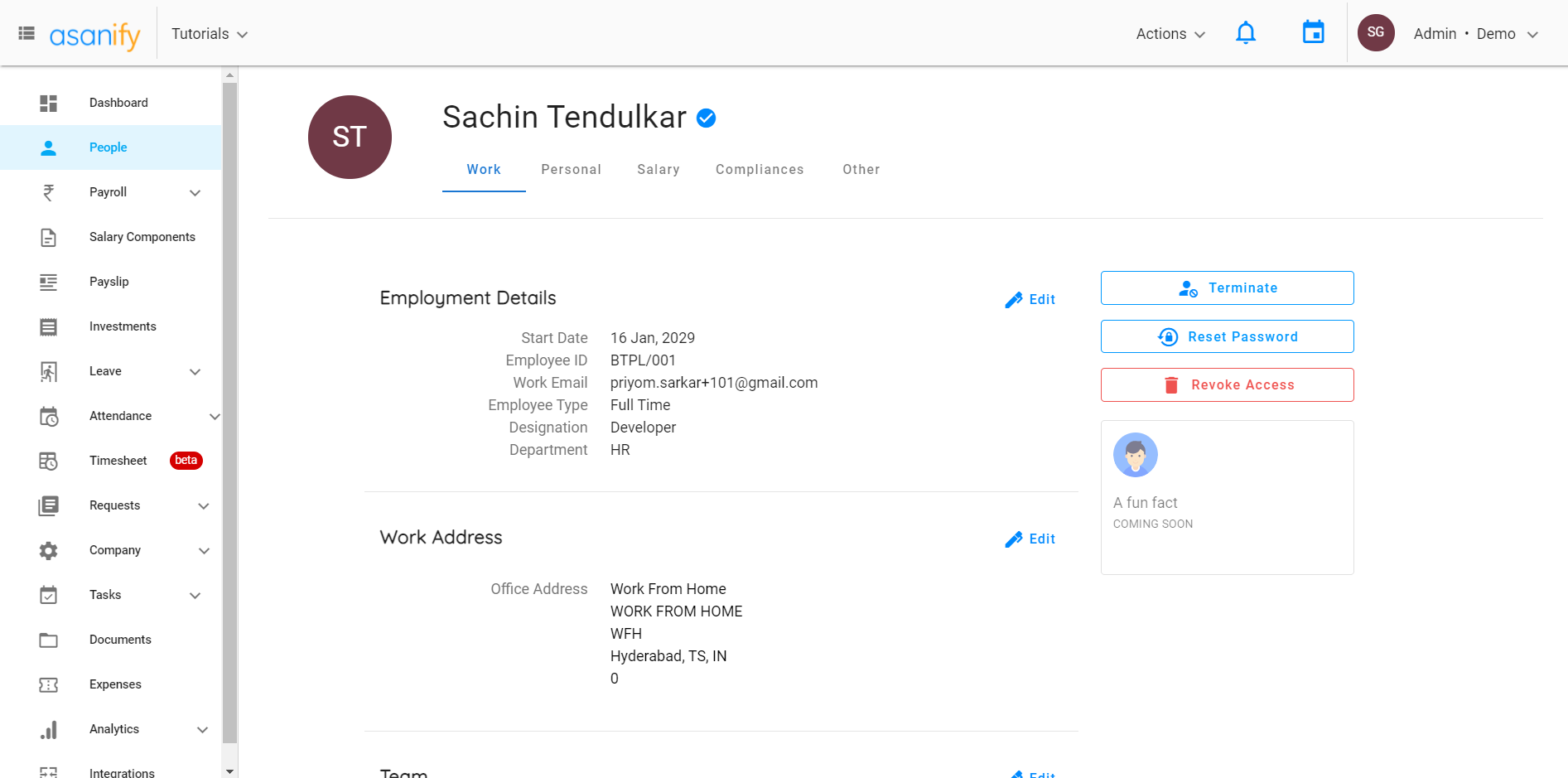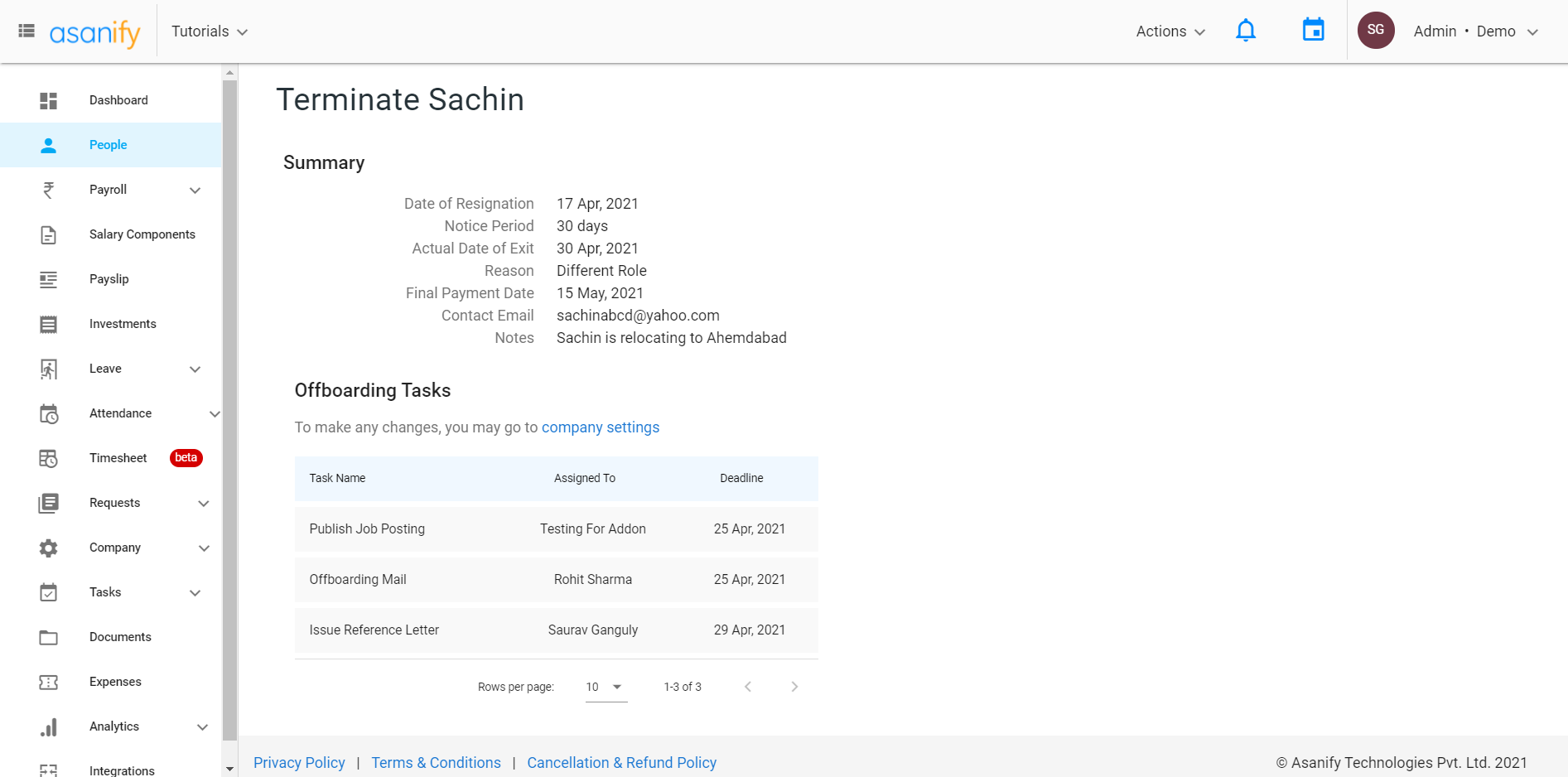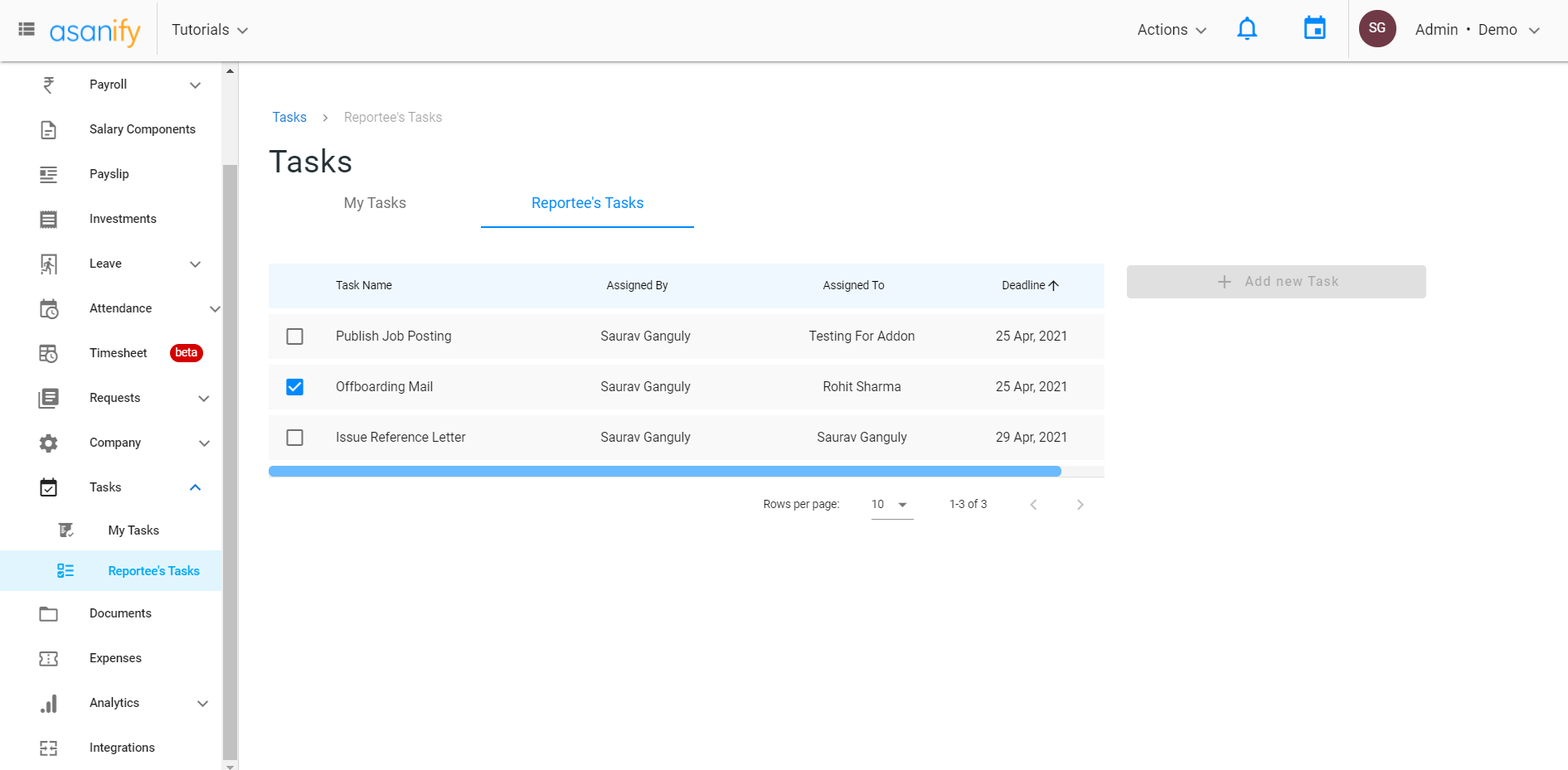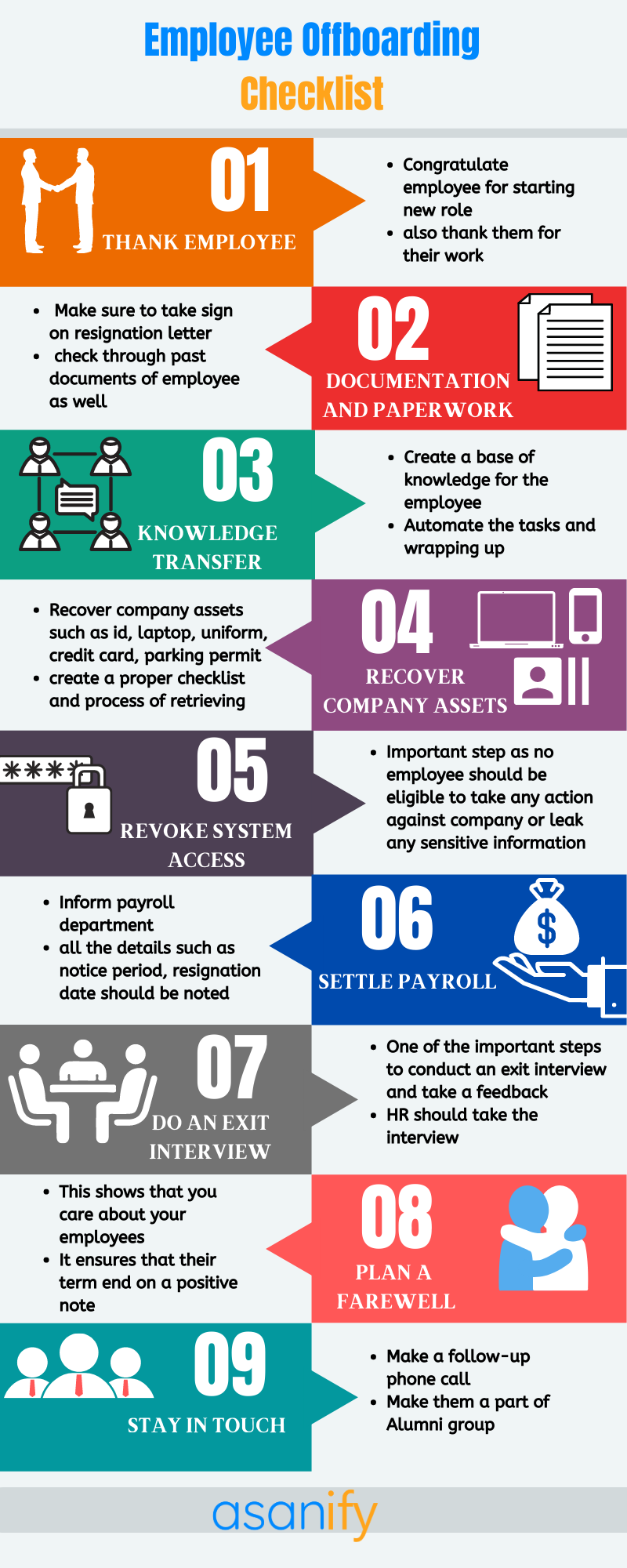How do you ensure smooth employee offboarding? Goodbyes are never easy, but a good offboarding process can surely make it better and convenient. In this blog, I have written in detail about employee offboarding and answered all the questions you may have around the topic.
I have included,
- What is known as employee offboarding?
- Why is it important to plan employee offboarding?
- How is employee offboarding related to employer branding?
- What are the steps included in offboarding employees?
- Create a checklist
- Complete all documentation and paperwork
- Announce employees departure from department or company
- Create a plan for the transfer of knowledge
- Organize the handing over of company equipment and property
- Communicate termination to employee’s clients
- Conduct an exit interview
- Revoke access from the company’s accounts
- Settle employee’s financial accounts
- Plan a farewell
- Follow up with now former employee
- How does the use of automation help in employee offboarding?
- Things to keep in mind so as to ensure a positive offboarding experience
- How to offboard an employee with asanify
- Conclusion
- FAQs
What is employee offboarding?
Employee offboarding is a formal process that takes place when an individuals employment has ended. It includes all the processes and events that take place when an employee leaves an organization.
Employee offboarding is the last stage of the employee life cycle and probably one of the most underrated sub-functions of Human Resources. While roles like hiring, onboarding or even employee engagement get a huge amount of attention from the HR department, HR employees need to realize that offboarding also plays an important role in building employer reputation as well.
Employee termination can take place either voluntarily or involuntarily. Voluntary termination would include an employee leaving the job by choice. This could be because of the want to study more, family demands or even work relations among others. Involuntary termination could take place because of the employee partaking in unethical jobs, employee misbehaviour, violation of rules etc.
Why is it important to have a well-planned employee offboarding?
Saying goodbye to an employee can be tough. If not done correctly, it can leave a very bitter feeling.
We know that an onboarding process can set the right tone for an employee’s time with a company. When you onboard an employee well, it helps the employee increase productivity and you also create a better chance of making the employee stay with the company for a longer time. Similarly, an offboarding process will affect the way an employee remembers your company after they have left the organization. This can also affect how they interact and promote your organization as a corporate alumnus.
Planning a good offboarding process also helps
- Avoid wrongful continuation of salary payment
- Easier management of the logistics of transitioning job responsibilities from one employee to the next
- Avoid potential lawsuits for wrongful termination etc.
- Gather feedback to help improve the company for current employees
Apart from these the reasons mention below also talk about the importance of a good employee offboarding process.
Makes employees feel important
Any employee who has been with your organization and worked for you deserves a graceful goodbye. When you put in the effort to ensure an effective offboarding process, you make the employee feel appreciated and important. This feeling of appreciation is replicated in the way they talk about your company later on and will affect the way they promote your brand as well.
Prevents room for error or confusion
Planning for a proper offboarding process enables both you (the HR) and the employee to be aware of every task that needs to be done as a part of the process. In that way, there is no error or confusion in terms of the documentation or offboarding paperwork. It also gives the employee clarity in terms of their last working day or even information about the pension etc. All errors or confusions can especially be taken care of when you integrate your employee offboarding process with HR software. This will help you keep track of all the different steps involved in the process along with the documentation and paperwork as well. 
Helps boost the morale of the current employees
How does offboarding an employee boost the morale of employees who are still working for you? When someone leaves an organization, they leave behind the team of people they used to work with. This can cause distress within the team. A change in group dynamics also can take place. In such a situation, when you make the effort to plan and conduct a quality onboarding process, you not only make the employee who is leaving feel important, but also the employees who still work for you. It sends a message that your care for each and every one of your employees even after they decide the leave the company or you let them go.
Creates room for future collaborations
Very often companies hire contractors temporarily. But they need someone they can trust. If your employee leaves the company on good terms, they are more likely to come back to work with you for an assignment or two.
Another way to collaborate in the future is- if they are now part of a business or company that is complementary to yours. They will be more likely to trust you and work together.
How is employee offboarding correlated with employer branding?
Offboarding when done right can bring about a positive effect on the entire company and hence on employer reputation as well. Employees will remember their time in your company based on the last few days spent there. How they remember your company is will affect how they talk about your company, either to current employees, employees at their new place of work or even friends and relatives. If they say negative things, needless to say, it will create bad publicity. But there are other reasons why employer branding needs to be good in the eyes of past employees. Here’s why.
Increase your chances of gaining boomerang employees
We all know what a boomerang is. And boomerang employees are no different. They are employees who leave the job, but eventually, come back to work for you again. Would it be great if you could get back some of the trusted former employees to rejoin your team? When employees leave on good terms, there is a good chance they could come back. A good offboarding process ensures that they do in fact leave on good terms.
A strong alumni network helps current employees work better
Former employees making current employees work better may seem a little odd right? Wrong! When an employee leaves your organization, assuming they did so on good terms, you can always count on them to come back to mentor or help your current employees. You could get them back to conduct a session for current employees to learn something new as well. Things like this help current employees remain motivated and give them a better shot at learning more. After all who better to learn from than someone who has walked the path before you.
Increase loyalty in the team
As I mentioned earlier, when an employee leaves a job, he or she leaves behind a team of people, hence, group dynamics change. But when you provide a good offboarding, it creates a good sense of loyalty among current employees. This is because they see that even when an employee is leaving, they receive just as much importance and respect. As a result, you have made them feel appreciated indirectly. Hence, motivation increases, and so does loyalty towards the company.
What are the steps that must be included in employee offboarding?
The entire process of offboarding can feel extremely tedious and exhausting. Especially because it is being done for someone leaving the company. That being said, you absolutely cannot take any of these below steps lightly as each of them work towards a more positive, better and healthier work environment. You should also use project management tools to easily keep track of the many tasks that need to be completed.

Make an offboarding checklist
Of all the steps, this one is the most important, for the sole reason that after doing this you won’t forget any of the other steps in the process.
Before you begin anything else, consider the role of the employee within the organization, what kind of employee termination is taking place and then write down a list of things to do and paperwork to get out of the way.
Complete all documentation and paperwork
The most important part of this step is making the employee sign a letter of resignation (if not done already). Make sure that the last working date is clearly stated in the resignation letter. After this has been done, the HR or employee’s supervising manager should through all the past paperwork the employee has signed. These for example include the NDA i.e. non-disclosure agreement or other contracts signed at the time of hiring, employee benefits documents etc.
Announce employees departure from department or company
The best way you could do this is by sending out emails. Keep these emails informative but short and crisp. You should definitely include details about
- Last working day
- If the person is being replaced (if yes, then by who)
- New work protocol (for the team which is losing an employee)
- If it is appropriate you could add the reasons for the employee exit
- You could also add information about a farewell get together if you are organizing one
- You should also remember to be appreciative of the employee (who is leaving) in the mail
Create a plan for the transfer of knowledge
This stage includes the wrapping up of all pending tasks before the employee exits. It also focuses on creating a base of knowledge for the new employee i.e. the replacement to begin their job. When this is done well, the transition becomes smooth and the employee filling in the space of the old employee will be able to do a better job.
Organize the handing over of all company equipment or property
Does your company provide any equipment that helps them work? Do you provide items like
- Laptop
- ID card
- A uniform
- Company credit cards
- Parking permits etc.
If you do, then you need a systematic way to collect them from the employee before their exit. Create a checklist for this as well and ensure someone from the managerial team oversees this process. Employees not returning such items can eventually lead to a huge loss for your company
Communicate to the employee’s clients about termination
Is this particular employee someone who directly deals with your company’s clients? You need to then inform their clients that this particular employee will not be working with them anymore. While doing this you should also mention which other employee will be taking over instead of the one that is leaving. This a common courtesy that needs to be extended. You could either get the employee who is leaving or their supervising manager to speak to the clients.
Conduct an exit interview
This step becomes extremely important when the employee decides to leave of his own volition. An exit interview is done so that you can get a detailed understanding of why the employee wants to leave and if there is anything that can be done to further better the working of your employees.
You should also have an HR representative ask the questions rather than the immediate supervisor. The employee may be less likely to openly talk to his supervisor, even if he is leaving soon. Your exit interview questions should include, but not be restricted to the ones I have listed below. You should also think of a few questions that may be applicable to your company which I haven’t mentioned below
- What made you decide to leave the organization?
- What are a few things that you dislike the most about the company? OR, Name of few things you would like to change about our company.
- How easy or difficult was it for you to get the resources required for you to do your job?
- Was it easy or difficult to work with your team members?
- How did our company help or harm your personal career growth and plans?
- Is there anything else you’d like to mention before we finish the interview?
The point of conducting an exit interview is to improve the company’s work environment or culture. When you receive feedback based on the above questions, act on it. Sometimes, employees provide negative feedback based on things that you can’t help with, either because of budget constraints or other reasons. It is up to you to decide which responses to consider for change and which not to.
Revoke access from all of the company’s accounts
This step is crucial because after employment is terminated, no former employee should be able to take any action against the company or leak any sensitive information to any competitor etc.
Settle employee’s financial accounts
This step should be very complicated if you use any payroll software. If you don’t, you should probably adopt one as soon as possible. You should also go through all the employee’s documents got to keep track of their pension, severance package etc. Make sure that the employee is taken off the payroll system if your software doesn’t automatically update it while offboarding.
Plan a farewell
When one of your employees are going away, it is of utmost importance to show them you care. Make them feel loved and appreciated for the time they spent at your company.
When you plan a farewell for an employee, it doesn’t need to be elaborate, especially when you’re part of a startup. You could just gather the team for a lunch or dinner get-together to show the employee you care for them and appreciate them.
Follow up with the now former employee
Keep in touch with the employee. You could make a follow-up phone call and talk about their current place of work. Another way you could keep in touch with them is via LinkedIn. Remaining in contact with former employees will benefit you in the long run.
How does the use of automation help in employee offboarding?
The future of HR is pretty much here! There has been an increase in the use of AI in HR over the past few years. Now, when you do the entire offboarding process manually, you are likely to make errors and take a huge amount of time. There’s also a high chance of missing out on various steps in the offboarding process. Things like the failure of keeping track of the pension of ex-employees or even forgetting to conduct an exit interview can occur. But when you use software, there are zero chances of such errors because the software can keep track of everything for you.
Allows for security and compliance
In a recent research done by ‘one login’, it was found that over 50% of Ex-Employees still have access to corporate applications. This causes a real security problem for companies when your ex-employees can still access accounts or cause a breach in data. When automation is used such errors are eliminated and taken care of.
Creates overall positive experience for the employees
I have already mentioned previously, a good offboarding process always provides for a better employee experience. This process can be smoothened out and made efficient with the help of HR software. It will
- Increase the productivity of your HR team
- Facilitate the transfer of knowledge between employees
- Schedule the exit interview automatically
- Allows employees to submit data, forms and documents via the software
- HR Chatbots can instantly solve any queries that may arise during the entire offboarding process.
Things to keep in mind during the employee offboarding process
Now that you know the steps involved in the offboarding process. you need to keep a few things in mind while carrying out those steps. They are,
- Be authentic while showing emotions towards employees. Don’t come across as fake for the sake of being overly nice
- Don’t cut off access to the various company equipment or accounts too early. Having said that, don’t forget to do it either
- Throughout the process show appreciation towards the employee for the work they have done in your company
- Keep a track of the activities of the corporate alumni network and ensure that the newly offboarded employee joins the network
- Begin looking for a replacement. (While this point doesn’t affect the soon to be ex-employee, it makes a huge difference to you. The sooner you get a replacement the smoother the transition from the old employee to the new one will be)
How to use Asanify for a seamless employee offboarding process
Here’s how you can easily offboard an employee using Asanify.
- Go to the ‘company settings’ page
Within the company settings page, click on the offboarding section. You will see a list of tasks that range from downloading personal documents of the employee, revoking access from accounts or returning company equipment.

- Set tasks applicable to your company
As you can see in the image, in the previous step, you can add, subtract or modify the tasks your wish to include in your companies offboarding process.
- Configure the employee offboarding tasks
Customize the entire process as per the needs of specific departments or even employees.
- Go to the ‘people’ page then in the ‘work’ section
You will be able to see all the details of the employee as shown below. You can terminate the employee from here.

- Add details about employee termination
Here, you can add information such as the employee’s exit date, the reason for termination, date of final payment and even add personalized notes.

- Click on the terminate button
After filling in the details, click on the terminate button. After this, you and the employee will be able to proceed to carry out the offboarding process.

- View summary of the employee offboarding details and offboarding tasks

- Go to the ‘tasks’ page
Here you can keep track of all the offboarding tasks that need to be completed as shown in the images below

- Employee and employer will be able to see tasks to be completed
No task will go unfinished as both the employee and employer will be able to keep track of tasks’ deadlines as well.
Check out the complete guide on: How to offboard an employee as an admin?
Conclusion
Offboarding any employee is never easy. Apart from the fact that it’s a goodbye, there are tons of tasks to be completed. Right from transferring company data and equipment to settling financial accounts, I hope this blog has helped you understand the things that have to be to efficiently offboard an employee without any bitter feelings.
FAQs
Employee offboarding is the formal separation of the employee from the company. For the employee, it means the employment has come to an end, either voluntarily to involuntarily.
There are many steps involved in offboarding an employee. They are
1. Create an offboarding checklist
2. Completion of all documentation and paperwork
3. Announce employees departure in department or company
4. Create a plan for the transfer of knowledge from
5. Organize handing over of all company equipment or property
6. Client communication (in case employee is directly involved in client communication)
7. Conduct an exit interview
8. Revoke access from company accounts
9. Settle financial accounts
10. Plan a farewell
11. Follow-up with the former employee
The employee exit process is another term used for employee offboarding. It is carried out when an employee leaves an organization either because he was fired or wanted to leave of his own volition. In both cases, there are a series of tasks to be completed both by HR as well as the employee’s supervisor which forms the offboarding process.
Employee onboarding takes place when a new employee has just joined a company, it is the next step in the employee cycle after recruitment. Offboarding on the other hand is when an employee is leaving the organization and is the last step in the employee life cycle.
A ready-reckoner on Employee Off-boarding for your quick reference:
Not to be considered as tax, legal, financial or HR advice. Regulations change over time so please consult a lawyer, accountant or Labour Law expert for specific guidance.
![You are currently viewing [Employee Offboarding] 11 step guide for an effortless process](http://3.219.171.151/wp-content/uploads/2021/04/Peach-Search-Bar-Valentines-Card-1.webp)










